Note: Video content on this page contains images of syringes and other medical equipment.
In the late 1800's, Chicago, like many other densely-populated cities, was a hotbed for contagion. In 1835, an outbreak of cholera finally prompted the creation of the Chicago Board of Health. Chronic underfunding and internal neglect, however, essentially declawed the department (Gale, Nugent). By 1907, the Chicago health department was on the offensive, directing significant funds towards building institutions for contagious diseases and hiring medical professionals for system-wide school inspections. In the two years leading up to this spur of action, however, the city was struggling to play defense, especially in regards to its schools. Representatives and witnesses from within the city’s health department cite three main points: 1.) slow response time, 2.) lack of appropriation and 3.) insufficient disease monitoring.

Scarlet fever is a bacterial infection of the nose and throat that can cause a rash. Though anyone can contract the disease, it is most common in children 5-15 years of age. Scarlet fever travels through respiratory droplets, and can be spread through talking, coughing, or sharing food and garments (CDC). Similarly, diphtheria, also a common cause of childhood death in Progressive-era Chicago, is a bacterial infection. Diphtheria can cause a high fever and the glands in the neck to become swollen. It is also spread through respiratory droplets (CDC). Though both infections can be treated with antibiotics, germ theory at the turn of the century was still underdeveloped. As a result, less emphasis was placed on curing, as was prevention.
For the containment of disease so commonly contracted and spread by children, Chicago Public Schools bore an oversized responsibility in the 1905-1907 epidemics. City officials made it clear that keeping schools open was preferable to letting children roam the streets. However, without sufficient medical inspectors to perform daily supervisions of each school, infection spread quickly. Eventually, funding for proper staff was allotted, but as Dr. Spalding, a medical official in charge of public health education, stated: "If we had been given 100 inspectors when we first asked for them we could have shut this thing off before now. We could have kept it out of schools" (Gale). Moreover, while the city eventually provided funding for medical inspection, other offensive services were dismissed. To summarize with a quote from Jane Addams on the matter: "We can legally appropriate money for physicians but not nurses [...] Where's the distinction? We can pay truant officers, but not nurses?" ("City Must Help Check Contagion").

At the height of the 1905-1907 epidemics, the suppression of reporting became such an issue that Dr Spalding was forced to declare that doctors who concealed cases of contagious disease were to be prosecuted. Underreporting, while partially due to negligence, was more so due to the lack of isolation hospitals in Chicago ("Epidemic Breaks Former Records"). Low-income families, especially immigrant families, were hit hardest by isolation guidelines, as the space and time available for caring for sick loved ones was already limited by uncertain employment and overcrowded households. As Dr. Walden, a commissioner in the city health department stated: "There is not one case in a hundred that can be isolated properly at home. Only the rich can afford it" (Gale).
Sources
"City Must Help Check Contagion" Chicago Daily Tribune, December 4, 1906.
"Epidemic Breaks Former Records" Chicago Daily Tribune, January 23, 1907.
Gale, George. "Forces Unite to Stamp Out Fever" Chicago Daily Tribune, February 1, 1907.
"Scarlet Fever: All You Need to Know." Centers for Disease Control and Prevention, Centers for Disease Control and Prevention, 27 June 2022, www.cdc.gov/groupastrep/diseases-public/scarlet-fever.html.
"Symptoms of Diphtheria." Centers for Disease Control and Prevention, Centers for Disease Control and Prevention, 26 May 2020, www.cdc.gov/diphtheria/about/symptoms.html
Nugent, Walter. Epidemics, www.encyclopedia.chicagohistory.org/pages/432.html.
